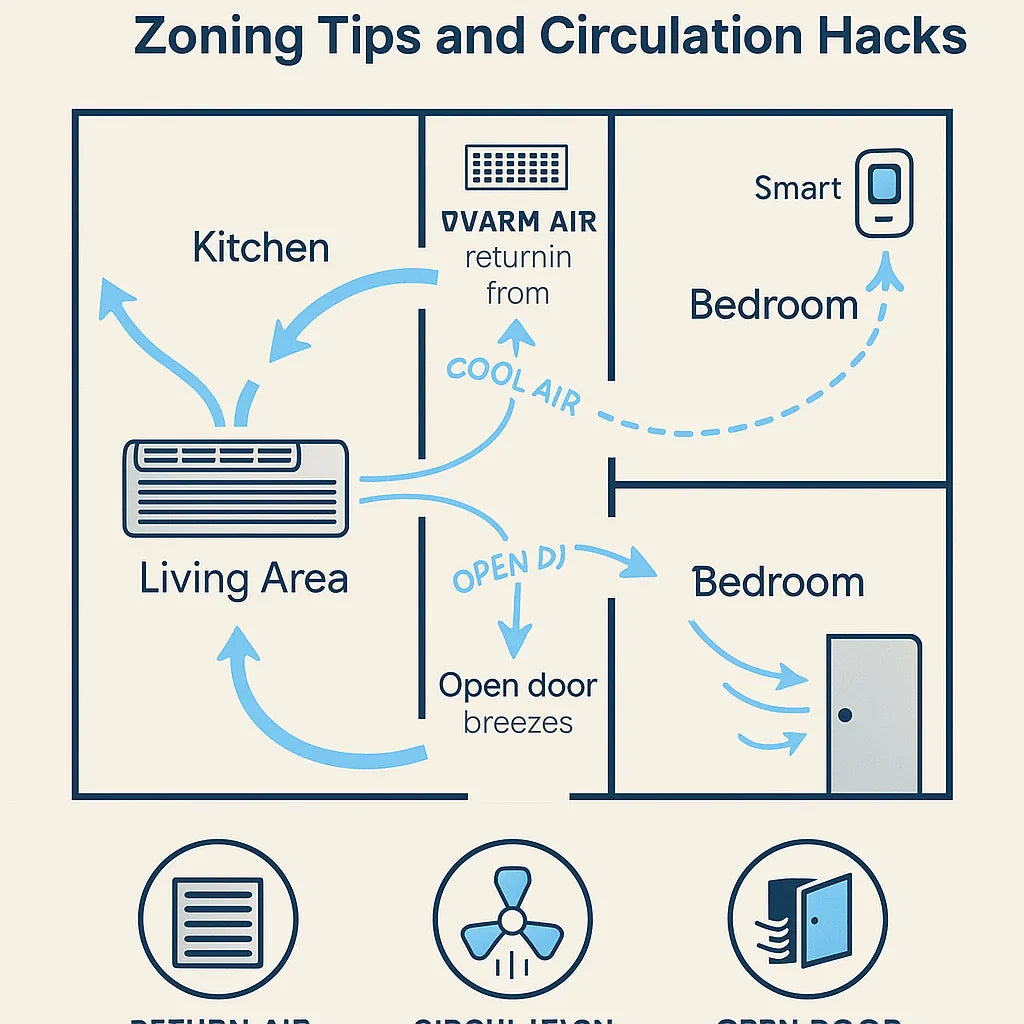When you install a GE Zoneline 15,000 BTU PTAC unit (Model AZHS15DCXXA), you expect strong, reliable comfort. But what if you want it to do more than just cool or heat a single room? Can it handle multiple rooms, like a bedroom plus a bath or an open-plan studio?
The answer: it depends on your layout, square footage, and circulation strategy. This guide will help Savvy homeowners determine whether one GE Zoneline unit can serve more than one space—and if so, how to do it efficiently.
🏡 The Zoneline’s Intended Coverage Area
The GE Zoneline 15,000 BTU PTAC unit is designed to condition spaces between:
-
500 and 700 square feet (cooling)
-
Slightly larger in heating mode due to rising heat and zoned airflow
It’s ideal for:
-
Studios and in-law suites
-
Hotel rooms and guest quarters
-
Open-plan offices or apartments
What it’s not designed for:
-
Multiple enclosed bedrooms
-
Two-story layouts
-
Long, narrow apartments with multiple walls
🛏️ What Layouts Work (and What Doesn’t)
| Layout | Compatible with One Unit? | Notes |
|---|---|---|
| Studio apartment | ✅ Yes | Open air, no door obstructions |
| Bedroom + en suite bath | ⚠ Maybe | Requires open door or return vent |
| Two bedrooms | ❌ No | Separate barriers block airflow |
| Open kitchen/living space | ✅ Yes | One of the best use cases |
| Office + storage room | ⚠ Maybe | Circulation support needed |
Key Factors
-
Open sight lines = better air distribution
-
Closed doors = dead zones
-
Total square footage should not exceed 700–750 sq. ft.
🧰 Passive Zoning Hacks: Air Movement Without Ducts
The GE Zoneline is a self-contained unit without ductwork. But there are creative ways to spread its comfort beyond a single room.
🏢 Return-Air Transfer Grilles
-
Installed in the top portion of interior doors or adjoining walls
-
Allow airflow between rooms while doors are closed
-
Low-cost, DIY or pro install
🚪 Louvered or Vented Doors
-
Replace solid interior doors with louvered or slatted models
-
Allow passive convection from the primary space
🏙 Ceiling Fans or Oscillating Fans
-
Help circulate cooled or heated air into adjacent areas
-
Especially useful in layouts where one room feeds into another
🌬️ Powered Airflow Strategies
For more active air management between rooms, consider these tools:
♻ In-Wall Booster Fans
-
Installed in shared walls between spaces
-
Pull air from the conditioned room into the next room
-
Thermostat-controlled models available
🌍 Smart Ventilation Systems
-
Some wireless vent fans can balance airflow automatically
-
Requires a small upfront investment, but improves whole-home balance
🌡️ Temperature Monitoring for Multiple Spaces
To understand how well your cooling strategy is working, use remote temperature sensors.
Recommended Options:
-
Ecobee Room Sensors (for thermostat-linked control)
-
Govee Bluetooth Hygrometers (affordable + app alerts)
-
SensorPush WiFi Sensors (pro-level data logging)
These tools help track temperature drift between rooms, and fine-tune fan or vent settings.
❄️ How Cooling Circulates Differently Than Heat
Cooling Challenges:
-
Cold air sinks, making it harder to move into distant rooms
-
Requires circulation or fans to push air outward
Heating Advantages:
-
Warm air rises, naturally flowing into nearby upper spaces
-
One Zoneline unit may heat two connected rooms better than it cools them
That said, closed doors block both cooling and heating—even if warm air can migrate more easily.
🔺 When One Unit Isn’t Enough
You may need a second Zoneline or a different solution if:
-
Your rooms are completely separated by walls/doors
-
Temperature difference exceeds 8°–10°F between rooms
-
Space exceeds 750 sq. ft. total
-
You need independent climate control per room (e.g. rentals)
⚡️ Alternative Options for Multi-Room Control
If your layout demands more flexibility:
🏠 Add a Second Zoneline
-
Common in duplexes, hotels, and basement suites
-
Each unit gets its own sleeve and thermostat
❄️ Use a Ductless Mini Split System
-
More flexible with zone-specific control
-
Higher SEER ratings, ultra-quiet operation
✅ Final Verdict: Can It Work?
Yes—one GE Zoneline unit can cool or heat multiple rooms if:
-
The layout is mostly open
-
Rooms are connected by transfer vents or doors are left open
-
Total space is under 750 sq. ft.
For best results:
-
Use ceiling fans or in-wall boosters
-
Add return air pathways
-
Monitor temps with smart sensors
Need help designing a circulation strategy around your Zoneline? Share your floor plan or square footage, and I’ll help you map the airflow!
In the next topic we will know more about: Is 15,000 BTUs Enough? Sizing Your GE Zoneline PTAC for Maximum Comfort







